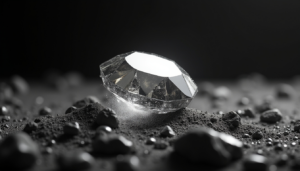Introduction to Diamond Formation
Diamonds have fascinated humanity for centuries, not only because of their beauty but also due to their unique physical properties. Traditionally, it has been understood that diamonds form deep within the Earth under extreme pressure and temperature conditions. However, recent research has revealed that these precious minerals can also originate under extraordinary circumstances, such as in meteorite impact craters.
At Diamantes we explore in depth the origin and characteristics of these fascinating gems. This time, we will address one of the most unusual ways they are created: diamonds formed by the impact of extraterrestrial bodies.
Diamond Formation Mechanisms on Earth
Traditional Geological Processes
Most natural diamonds are formed in the Earth’s mantle, at depths greater than 150 kilometers, where pressures and temperatures are high enough to crystallize carbon into diamond. These diamonds are transported to the surface by volcanic eruptions through kimberlite pipes. You can learn more about this process in our article on how diamonds form in nature.
Formation in Meteorite Impact Craters
In addition to geological processes, diamonds can also form when a meteorite collides with Earth. The impact generates extremely high pressures and temperatures in fractions of a second, creating ideal conditions to transform carbon present in surrounding rocks into microdiamonds or impact diamonds.
The Role of Meteorite Impacts in Diamond Creation
Physical Conditions During the Impact
When a meteorite impacts the Earth’s surface, it releases an enormous amount of energy in a localized area. This energy results in shock waves that instantly raise the pressure and temperature of the material at the impact site, reaching levels comparable to those in the Earth’s mantle.
Transformation of Graphite into Diamond
If the impact zone contains carbon-rich minerals, such as graphite, the extreme conditions can lead to their transformation into diamond. This process has been widely documented in various craters around the world, and in some cases, even the formation of lonsdaleite—a hexagonal variant of diamond—has been identified.

Notable Examples of Impact-Formed Diamonds
The Popigai Crater and Its Diamonds
One of the most remarkable examples is the Popigai Crater in Siberia, Russia. This crater, approximately 100 kilometers in diameter, formed about 35 million years ago. Research has revealed that the impact transformed graphite present in the rocks into diamonds, creating one of the largest known impact diamond deposits.
Microdiamond Discoveries in Other Craters
In addition to the Popigai Crater, microdiamonds have been found at other impact sites, such as the Ries Crater in Germany and the Sudbury Crater in Canada. These findings support the hypothesis that meteorite collisions have contributed to the distribution of diamonds across various regions of the planet.
Unique Properties of Impact Diamonds
Structural Differences from Conventional Diamonds
Impact diamonds are usually smaller and may contain different internal structures due to their rapid formation conditions. Lonsdaleite, for example, has a hexagonal structure that makes it even harder than traditional diamond.
Industrial and Scientific Applications
Thanks to their extreme hardness, impact diamonds have industrial uses, especially in cutting and abrasion tools. Additionally, their study provides valuable insights into geological and astronomical processes related to cosmic impacts.
Conclusion
The formation of diamonds in meteorite impact craters represents a fascinating chapter in the geological history of our planet. These diamonds, born from violent and extreme events, remind us of the complexity and diversity of natural processes. At Diamantes.com, we continue exploring all facets of this extraordinary gem, from its formation in the Earth’s mantle to its creation by cosmic forces.
Frequently Asked Questions
What are impact diamonds?
They are diamonds formed by the extreme pressure and temperature generated when a meteorite impacts the Earth’s surface.
Where are impact diamonds found?
They have been discovered in several craters, including the Popigai Crater in Russia, as well as Ries (Germany) and Sudbury (Canada).
Are impact diamonds the same as conventional diamonds?
No. They may differ in size, internal structure, and origin, and some contain harder forms such as lonsdaleite.
Do impact diamonds have commercial value?
Yes, especially in industry. Due to their hardness, they are used in cutting tools, although their use as gemstones is limited.




